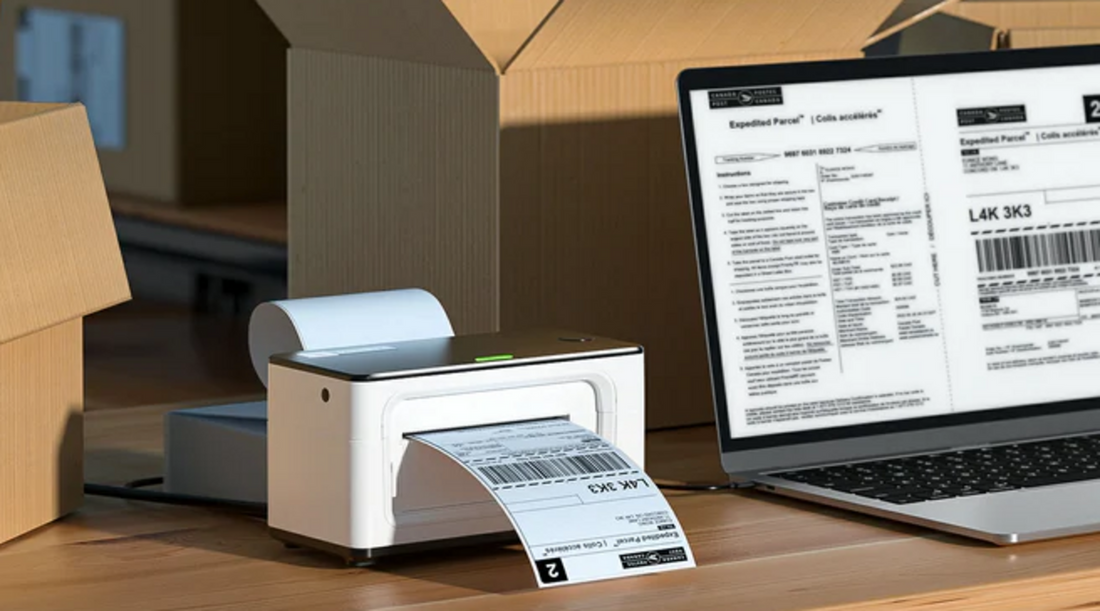Can You Print on Normal Paper with a Thermal Printer?

Have you ever marveled at the smooth, quick process of receiving a printed receipt or shipping label and wondered about the magic behind it? The secret lies in thermal printers and thermal paper. These devices are integral parts of many businesses and personal setups because they're efficient and cost-effective. Today, we explore whether it's possible to use normal paper in a thermal printer.
What Is Thermal Paper?
Thermal paper is a special type of paper that changes color when exposed to heat. It's commonly used in various machines like POS systems, cash registers, and even some medical equipment. This paper is known for its high-quality prints and speed.
The unique feature of thermal paper is its heat sensitivity. The surface of this paper is coated with a mixture of dye and developer. Upon contact with the heated print head of the thermal printer, the coating reacts, resulting in a crisp, clear image or text. Standard sizes are usually roll-based, allowing for continuous printing without frequent replacement.
Thermal paper is made up of multiple layers, typically three or four:The base layer is the main structure that provides support. On top of this is the substrate layer, which enhances stability and quality. The third layer is the thermal layer, where the magic happens – this layer contains chemicals that react to heat. Some advanced types also have a topcoat layer for added durability and protection against elements like water and oil.
What Does Normal Paper Refer To?
Normal or regular paper is the kind you use in everyday tasks – think of your printer at home or the office. Standard paper sizes include the familiar A4 (210 x 297 mm) and Letter size (8.5 x 11 inches), which comply with international standards for compatibility across various devices and uses.
This type of paper includes a wide range from plain white sheets to colored versions, and from lightweight to heavyweight stocks. It's versatile and widely available, making it ideal for numerous applications such as printing formal or official documents, flyers, and reports.
Normal paper is generally produced through a process involving cellulose fibers derived from wood or recycled materials. It lacks any special coatings or treatments, making it unsuitable for techniques that require heat activation, unlike thermal paper.
*anchor-1
How Thermal Paper Differ from Normal Paper?
When comparing thermal paper with normal paper, several differences stand out:
- Thickness: Thermal paper tends to be thinner but more robust due to its special layers. Normal paper comes in varying thicknesses depending on its purpose.
- Cost: Thermal paper can be slightly more expensive because of its specialized nature and coating processes. Regular paper is often cheaper and more readily available.
- Printing Quality: Prints on thermal paper are sharper and clearer due to the precise heat activation. Traditional ink or laser printers on normal paper may not achieve the same level of detail.
- Lifespan: Thermal prints can fade over time, especially when exposed to heat or light, although advanced coatings can prolong their lifespan. Documents printed on normal paper with good quality ink can last longer if stored properly.
- Applications: Thermal paper is primarily used for receipts, labels, and tickets, whereas normal paper is perfect for documents, notes, and artwork.
- Texture & Materials: Thermal paper has a smoother, almost glossy feel due to its coating layers. Normal paper varies in texture, from rough to smooth, depending on its type and intended use.
Can You Use Normal Paper in a Thermal Printer?
Unfortunately, thermal printers cannot use regular paper. This is because thermal printers generate images by heating specially coated thermal paper, while regular paper lacks this chemical coating.Thermal label printers are designed specifically for thermal paper. When the heated print head contacts the thermal paper, it activates the dye layer to produce images or text. Regular paper cannot react to the heat, and using it may not only fail to print but also damage the print head, shortening the printer's lifespan.
Additionally, thermal printers do not use traditional ink or toner, making maintenance low-cost. Using regular paper disrupts this system, resulting in unclear prints and negatively affecting device performance. Therefore, using recommended thermal paper is crucial for ensuring optimal print quality and device durability.
What Can You Do If You Own A Thermal Printer?
Owning a thermal printer opens up a world of possibilities, depending on your needs and types of printers you choose:
For online business owners: A thermal printer can improve your operations significantly. You can print shipping labels for efficient product delivery, ensuring packages are labeled clearly and professionally. You can also create custom stickers to add a personal touch to your packaging, enhancing customer experience.For retailers: Thermal printers are indispensable for printing receipts quickly and efficiently. With the right set-up, you can print product information, price tags, and any promotional material directly onto labels, streamlining your point-of-sale operations.
For personal users: Thermal printers offer creative avenues for personal projects. Whether you're organizing your home with custom labels and stickers, creating DIY crafts, or even printing daily checklists and to-do lists, these printers are incredibly versatile. For those needing larger formats, portable A4 thermal printers allow you to print full-sized documents anywhere, anytime.
*anchor-2
To Sum Up
While it might be disappointing that normal paper isn't compatible with thermal printers, their specialized nature brings unparalleled benefits. From business efficiency to personal creativity, thermal printers serve diverse needs effectively. Choosing the right type of paper—thermal for specialized tasks and regular for everyday uses—ensures you make the most of your printer's capabilities. So, embrace the unique features of each type of paper and let them complement your printing needs!





